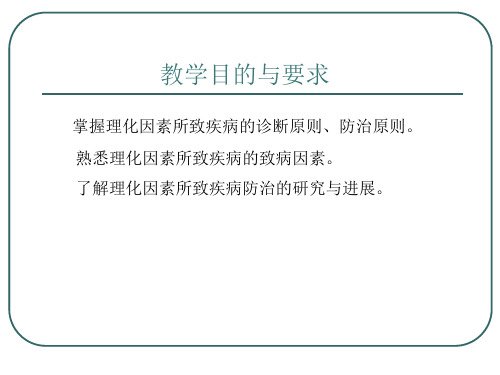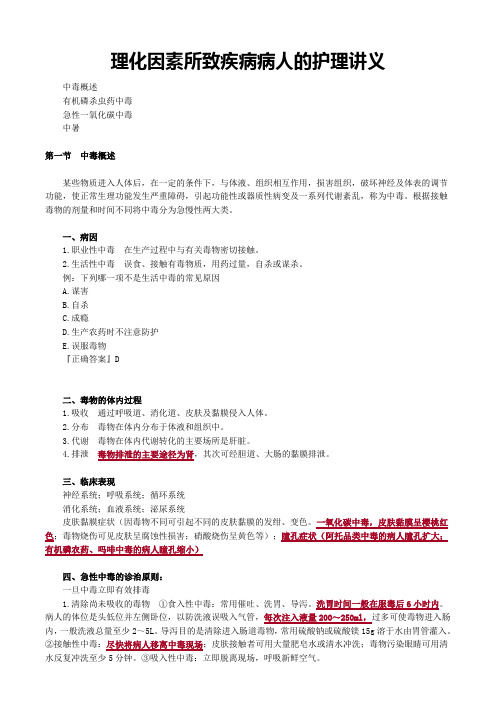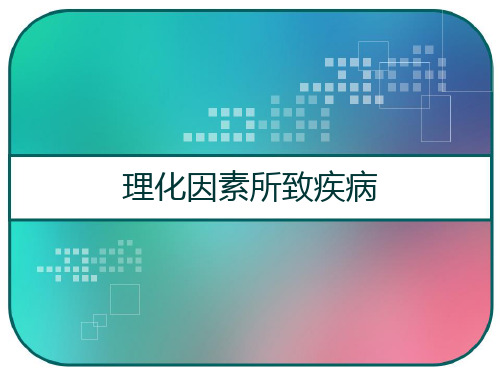理化因素所致疾病讲义
第十一节 常见理化因素所致疾病ppt课件

催吐:应马上用手指或筷子刺激咽喉、舌根 催吐,将毒物吐出。催吐后,再快速饮清水 300~500毫升,并再次催吐。如此反 复多次,直到吐出的水澄清无毒物为止。 磷化锌中毒时,应禁食油类食物及牛奶、鸡 蛋、肥肉等脂肪性食物,以防磷溶解后,加 剧中毒。 如果是安妥中毒,应忌食脂肪类及碱性食物, 要少喝水,禁用碳胺氢钠(小苏打)、肥皂 水洗胃,以免加重中毒。
【诊断要点】
根据病史及症状可以确诊。 一氧化碳检查法: ①血液呈樱桃红色; ②取血一滴加至一杯水中呈微红色(正常人为 黄色); ③取血数滴加水10ml,加10%氢氧化钠数 滴,呈粉红色(正常人的血呈绿色)。
供氧非常重要,因为吸入氧浓度越高,血内一 氧化碳分离越多,排出越快。 研究表明,血中一氧化碳减半时间,在室内需 200分钟,吸纯氧时需40分钟。故应用高压 氧舱是治疗一氧化碳中毒最有效的方法。 将病人放入2~2.5个大气压的高压氧舱内, 经30~60分钟,血内碳氧血红蛋白可降至0, 并可不发生心脏损害。 中毒后36小时再用高压氧舱治疗,则收效不 大。故及早进高压氧舱,可以减少神经、精神 后遗症和降低病死率。高压氧还可引起血管收 缩,减轻组织水肿,对防治肺水肿有利。
出水后的救护:首先清理溺水者口鼻内污 泥、痰涕,有假牙取下假牙,然后进行控 水处理。救护人员单腿屈膝,将溺水者俯 卧于救护者的大腿上,借体位使溺水者体 内水由气管口腔中排出。 有些农村将溺水者俯卧横放在牛背上,头 脚下悬、赶牛行走,这样又控水、又起到 人工呼吸作用。 如果溺水者呼吸心跳已停止,立即进行口 对口人工呼吸,同时进行胸外识到已发生一氧化碳中毒时,往往已 为时已晚。因为支配人体运动的大脑皮质最先 受到麻痹损害,使人无法实现有目的的自主运 动。此时,中毒者头脑中仍有清醒的意识,也 想打开门窗逃出,可手脚已不听使唤。所以, 一氧化碳中毒者往往无法进行有效的自救。 在日常生活中,家庭用火、取暖、洗浴时缺乏 预防措施,是导致一氧化碳中毒的主要原因。 临床以头痛乏力,口唇呈樱桃红,甚者出现昏 迷为特征。
内科PPT课件第九篇5年制 理化因素所致疾病 8版(ppt文档)

6 泌尿系统
7 血液系统 溶血性贫血 白细胞减少 出血 血凝障碍
8 发热
14
临床表现*
二、慢性中毒
神经系统 痴呆、周围神经病 消化系统 中毒性肝病 泌尿系统 中毒性肾病 血液系统 粒细胞减少症、再生障碍性贫血 骨骼系统 氟骨症
15
诊
• 急性中毒及早诊断
断*
• 慢性中毒查找病因
• 职业中毒慎重对待
• 2。烟碱样表现 (N样症状)横纹肌神经肌肉接头胆 碱蓄积和刺激,使面、眼睑、舌、四肢和全身肌纤维 颤动,肌肉痉挛,肌力减退、肌肉麻痹、呼吸肌麻痹 引起周围性呼吸衰竭。
• 3。中枢神经系统表现 (M、N) 受乙酰胆碱刺激后, 有头晕、头痛、失眠或嗜睡、记忆力减退、乏力、烦 躁、语言障碍、精神恍惚、惊厥、昏迷、脑水肿。
10
病因和中毒机制
(二)中毒机制 1.体内毒物代谢 (1)毒物侵入途径
1)消化道 2)呼吸道 3)皮肤黏膜 (2)毒物代谢 氧化、还原、水解、结合。 (3)毒物的排泄 呼吸道、消化道、肾脏、皮
肤、乳汁等。
11
病因和中毒机制
2.中毒机制
①局部刺激和腐蚀作用 ②缺氧 ③麻醉作用 ④抑制酶的活力 ⑤干扰细胞或细胞器的功能 ⑥竞争相关受体
12
病因和中毒机制
3.影响毒物作用的因素 (1)毒物的理化性质 (2)机体状态 个体的易感性 (3)毒物相互影响
13
临床表现*
一、急性中毒
1 皮肤黏膜 灼伤、发绀、黄疸
2眼
瞳孔 、 视神经
3 神经系统 昏迷、瞻妄、肌纤维颤动、惊厥、瘫痪
4 呼吸系统 呼吸气味、呼吸频率、肺水肿
5 循环系统 心率失常、 心跳骤停、 休克
• 八、非电离辐射 电光性眼炎
理化因素所致疾病课件PPT课件(精品医学课件)

口服中毒多见 • 百草枯中毒患者常以肺的损害为特点
百草枯中毒严重程度分型
轻型
摄入百草枯的量< 20mg/kg,无临床 症状或仅有口腔 黏膜糜烂、溃疡, 可出现呕吐、腹 泻
中到重型
摄入百草枯的量> 20mg/kg,部分患 者可存活,但多 数患者2~3周内 死于肺功能衰竭
暴发型
摄入百草枯量> 40mg/kg。1~4日 内死于多器官衰竭
百草枯中毒处理
百草枯无特效解毒 剂,必须在中毒早 期控制病情发展, 阻止肺纤维化的发 生
阻止毒物继续吸收 加速毒物排泄
防止肺纤维化 对症与支持疗法
百草枯中毒处理
• 阻止毒物继续吸收: 脱去污染衣物,肥皂水清洗皮肤、毛发。眼部清水冲 洗。 立即催吐并口服白陶土悬液或就地取材用泥浆水100~ 200ml口服;白陶土洗胃后口服活性炭或15%的漂白土 (吸附剂);导泻。
理化因素所致疾病
Diseases induced by harmful environmental events
氨基甲酸酯类、拟除虫 菊酯类、有机氮类杀虫药中毒
概述
• 病因
• 因生产或使用不当、自服或误服使毒物进入 体内
发病机制
氨基甲酸酯类杀虫药 毒理与有机磷杀虫药相似,可直接抑制乙酰胆碱酯酶。 因其在体内易水解失活,胆碱酯酶活性常于2~4小时后 自行恢复
氧气吸入,或呼吸末正压通气。 肺损伤早起给予正压机械通气联合激素对百草枯中毒引
起的难治性低氧血症患者具有重要意义。
百草枯中毒处理
• 对症及支持: 保护胃黏膜 保护肝、肾、心肌功能 防止肺水肿 预防、控制感染
镇静催眠药中毒
常见理化因素所致疾病医学PPT

治理措施
监测网络建设
法律法规
制定和完善相关法律法规,明确理化因素所致疾病的防治要求和责任,为预防和控制工作提供法律保障。
政策引导
制定相关政策,鼓励和支持有利于预防和控制理化因素所致疾病的科研、生产和消费行为。
04
CHAPTER
治疗原则
医生应遵循安全、有效、经济、合理的原则,为患者制定个性化的治疗方案,以达到最佳的治疗效果。
THANKS
感谢您的观看。
化学因素主要通过与人体组织器官的相互作用,影响人体的酶活性、细胞膜通透性、细胞信号转导等过程,导致细胞和分子水平的损伤和功能障碍。
02
CHAPTER
常见理化因素所致疾病
烧伤
由高温、火焰、电流等物理因素引起的皮肤及深部组织损伤。
冻伤
由于低温引起的局部或全身性损伤。
辐射病
长时间暴露于电磁辐射或放射性物质引起的疾病。
噪声污染相关疾病
03
CHAPTER
理化因素所致疾病的预防与控制
通过媒体、社区活动、学校教育等方式,普及理化因素对健康的危害,提高公众的自我保护意识。
公众教育
制作和传播健康宣传资料,包括海报、视频、手册等,向公众传递正确的健康知识和行为。
健康宣传
建立和完善环境监测网络,定期对环境中的理化因素进行检测,及时掌握污染状况。
理化因素所致疾病的诊断与治疗
诊断方法
医生会根据患者的症状、体征和实验室检查结果,结合疾病流行病学资料,进行综合分析,确定诊断。
诊断原则
医生应遵循科学、客观、全面的原则,对患者的病情进行全面了解,以便做出准确的诊断。
治疗方法
最新临床医学概要理化因素所致疾病PPT课件

4、其他:
1)、中毒复发:乐果、马拉硫磷等中毒, 经抢救好转后,症状又可复发,所以对此 类中毒的抢救阿托品一定不能停药过早, 并注意观察。
2)、迟发性神经病:以甲胺磷中毒多见, 在中毒后2~3周发生,表现为末梢神经炎, 有感觉、运动障碍,恢复较难。其发生机 制可能与有机磷抑制神经靶酯酶有关。
3、促进已吸收毒物的排出:利尿、吸氧、血液 净化等,后者包括血液透析、血液灌流、血浆置 换等。
4、特殊解毒药的应用:
1)、中枢神经抑制药中毒可用纳洛酮解毒, 如吗啡、酒精、地西泮等中毒,而后者多用氟马 西尼更好。
2)、重金属中毒解毒药:依地酸钙钠可用于 铅中毒;二巯丙醇可用于砷、汞中毒,但二巯丙
磺钠和二巯基丁二酸钠效果更好,后者特别 适用于锑中毒。
1、毒蕈碱样表现:又称M样症状, 主要是副交感神经末梢过度兴奋。 表现为平滑肌痉挛和腺体分泌,前 者如如恶心、呕吐、腹痛、腹泻、 瞳孔缩小、支气管痉挛、呼吸困难; 腺体分泌增加表现为多汗、流泪、 流涕、流涎,支气管分泌增多表现 为咳嗽气促,严重者出现急性肺水 肿。
2、烟碱样表现:也称N样症状,主要为骨 胳肌和肾上腺素分泌的表现。如局部肌纤 维颤动、肌肉痉挛或抽搐,甚至出现全身 肌肉强直性痉挛;也可出现肌力减退或肌 肉麻痹,严重者出现呼吸肌麻痹和呼吸衰 竭;肾上腺素分泌出现心率加快、血压升 高,严重者出现心律失常、心肌炎、心力 衰竭、血压下降等。
洗胃液可据毒物的不同而选用。腐蚀剂 中毒可用牛奶、蛋清等保护剂;硝酸银中
毒可用生理盐水;脂溶性毒物可用液体 石蜡;强酸强碱中毒可用弱酸弱碱中 和;很多毒物可用活性炭吸附;许多 毒物可用特效解毒剂起中和、氧化、 沉淀等化学作用。
常用急救技术 理化因素所致疾病 理化因素所致疾病概述(临床诊疗课件)

诊断原则
4.流行病学调查分析 大多数理化致病因素致病的特点是在同一时间可能有多数
人发病,利用人群发病情况的流行病学调查方法,有助于明 确环境中的致病因素和预防发病。
诊断原则
理化因素所致的疾病虽然会出现一个或多个器官损伤或 衰竭,但临床上往往缺乏特异性表现。诊断时,在考虑环境 因素的同时,尚需结合接触式、临床表现和实验室检查,然 后再与其他临床表现类似的疾病鉴别,综合分析判断。
防治原则
1.迅速脱离有害环境和危险因素 2.稳定病人的生命体征 3.针对病因和发病机制治疗 4.对症支持治疗
检测方法。 药物中毒或毒物中毒可以通过检测估计中毒量; 空气中的毒物可以检测浓度; 环境温度、海拔高度等都能测量。
诊断原则
2.受损靶器官和部位 多种毒物都有其作用的靶器官和部位。 OPI吸收后抑制胆碱酯酶; 物理因素如噪声主要作用于听神经,加速运动主要作用
于前庭神经。
诊断原则
3.剂量与效应关系 量效关系是评估理化致病因素作用的基本规律 暴露毒物的量,高、低温环境时间长短等与疾病严重程度
生产的“三废”(废水、废气、废渣)污染,毒物可通过呼 吸、消化道和皮肤黏膜等途径进入人体引起中毒。
化学因素
1)农药 2)药物 3)乙醇 4)其他:误食清洁剂或有机溶剂造成的中毒,毒蛇咬伤中 毒,一氧化碳、氰化物等窒息性化合物引起的缺氧性中毒, 强酸和强碱引起的接触性组织损伤。
诊断原则
1.病因 此类疾病都在一定环境下发病,多数病因明确并有相应的
教学目的与要求
掌握理化因素所致疾病的诊断原则、防治原则。 熟悉理化因素所致疾病的致病因素。 了解理化因素所防治研究进展。
致病因素
1.物理因素 1)高温 2)低温 3)高气压 4)低气压 5)电流 6)其他
理化因素所致疾病病人的护理讲义

理化因素所致疾病病人的护理讲义中毒概述有机磷杀虫药中毒急性一氧化碳中毒中暑第一节中毒概述某些物质进入人体后,在一定的条件下,与体液、组织相互作用,损害组织,破坏神经及体表的调节功能,使正常生理功能发生严重障碍,引起功能性或器质性病变及一系列代谢紊乱,称为中毒。
根据接触毒物的剂量和时间不同将中毒分为急慢性两大类。
一、病因1.职业性中毒在生产过程中与有关毒物密切接触。
2.生活性中毒误食、接触有毒物质,用药过量,自杀或谋杀。
例:下列哪一项不是生活中毒的常见原因A.谋害B.自杀C.成瘾D.生产农药时不注意防护E.误服毒物『正确答案』D二、毒物的体内过程1.吸收通过呼吸道、消化道、皮肤及黏膜侵入人体。
2.分布毒物在体内分布于体液和组织中。
3.代谢毒物在体内代谢转化的主要场所是肝脏。
4.排泄毒物排泄的主要途径为肾,其次可经胆道、大肠的黏膜排泄。
三、临床表现神经系统;呼吸系统;循环系统消化系统;血液系统;泌尿系统皮肤黏膜症状(因毒物不同可引起不同的皮肤黏膜的发绀、变色。
一氧化碳中毒,皮肤黏膜呈樱桃红色;毒物烧伤可见皮肤呈腐蚀性损害;硝酸烧伤呈黄色等);瞳孔症状(阿托品类中毒的病人瞳孔扩大;有机磷农药、吗啡中毒的病人瞳孔缩小)四、急性中毒的诊治原则:一旦中毒立即有效排毒1.清除尚未吸收的毒物①食入性中毒:常用催吐、洗胃、导泻。
洗胃时间一般在服毒后6小时内。
病人的体位是头低位并左侧卧位,以防洗液误吸入气管,每次注入液量200~250ml,过多可使毒物进入肠内,一般洗液总量至少2~5L。
导泻目的是清除进入肠道毒物,常用硫酸钠或硫酸镁15g溶于水由胃管灌入。
②接触性中毒:尽快将病人移离中毒现场;皮肤接触者可用大量肥皂水或清水冲洗;毒物污染眼睛可用清水反复冲洗至少5分钟。
③吸入性中毒:立即脱离现场,呼吸新鲜空气。
2.促进已吸收的毒物排泄常用的方法有:①利尿;②吸氧;③血液透析;④血液灌流;⑤血浆置换。
3.阻止毒物的吸收常用特殊解毒剂的应用:①有机磷农药的解毒剂为碘解磷定、氯磷定;②阿片类、吗啡的解毒剂为纳洛酮;③亚硝酸盐、苯胺中毒所致的高铁血红蛋白症的解毒剂为亚甲蓝(美蓝);④急性氰化物中毒的解药是亚硝酸钠;⑤急性砷、汞等重金属中毒的解毒药是二巯丙醇等。
内科护理学(二)第九章 理化因素所致疾病

第一节 中毒总论
• 3.治疗要点 • (2)清除尚未吸收的毒物 • ①洗胃 • 洗胃液的选择:一般总洗胃液量至少2~5L,多至6~10L。 • 毒物不明者均可用温开水或生理盐水洗胃,若已知毒物种类,则
可选用适当的解毒物质或洗胃液中酌加相应解毒剂。 • a.解毒药:通过与体内存留的毒物发生中和、氧化、沉淀等反应,
• (3)对症治疗 给氧、吸痰、保持呼吸道通畅
第二节 有机磷杀虫药中毒
• 6.主要护理措施
• (1)病情观察 定时测生命体征,尤其是呼吸频率,观察意识状 态;观察发绀变化,听诊双肺湿啰音增减情况,若呼吸增快、变 浅要及时通知医生;了解胆碱酯酶测定结果及动脉血氧分压变化; 记出入量及重病记录。
• (2)体位 清醒者可取半卧位,昏迷者卧位头偏向一侧,注意保 暖。
第二节 有机磷杀虫药中毒
• 3.临床表现(主要死因为呼吸衰竭) • (1)毒蕈碱样(最早出现)-腺体分泌增加及平滑肌痉挛(消化
道和呼吸道症状较为突出) • 恶心、呕吐、腹痛、腹泻;支气管痉挛及腺体分泌物增多 • (2)烟碱样 (肌纤维颤动)常先自小肌群如眼睑、面部开始,
逐渐发展至四肢、全身肌肉抽搐 • (3)中枢神经系统症状 早期头晕、头痛、乏力,逐渐出现烦躁、
• 2.病因和发病机制 • 2.1 病因 一氧化碳 是无色、无臭、无味的气体, • 2.2 发病机制:CO和血红蛋白亲和力强;结合肌球蛋白损害线粒体。 • CO经呼吸道进入血液后,与红细胞内血红蛋白结合形成稳定的碳氧
血红蛋白(COHb);且CO与血红蛋白的亲和力比O2与血红蛋白的亲 和力大200~300倍,同时COHb的解离较氧合血红蛋白的解离速度慢 3600倍,因而,• 4.主要护理措施 • (3)对昏迷者 • ③高热惊厥 遵医嘱给安定静脉或肌内注射,并给予物理降温,
理化因素所致急症ppt课件

冻伤
全身冻伤(冻僵)
早期患者寒战、发绀,疲乏、全身无力, 体温小于 33℃:嗜睡、呼吸心跳减慢,脉搏细弱,感觉 反应迟钝 体温小于26℃:昏迷,血压下降 心率失常 低糖髙钾,严 重者心跳呼吸骤停
常见的诱因:高温、烈日曝晒,工作强度过大、时 间过长、睡眠不足、过度疲劳等。
发病机制 机体内的热难于通过辐 当气温超过皮肤温度 (一般为32~35℃)。 射、传导、蒸发、对流 等方式散发,甚至还会 环境中有热辐射源(如 从外界环境中吸收热量, 电炉、明火)。 造成体内热量贮积,引 空气中湿度过高,通风 起中暑。 又不良时。
重症中暑
热痉挛(heat cramp)
发病机制:高温环境下大量出汗,造成失水和明显的
失盐(低钠低氯血症)。 起病突然,肌肉阵发性疼痛和痉挛。四肢先受累,肌 肉触摸有硬块感。 伴有恶心、呕吐、乏力,皮肤湿凉 或干热 。
生命体征稳定。
重症中暑 热衰竭(heat exhaustion)
临床表现 先兆中暑 轻症中暑 重症中暑 热痉挛、热衰竭、日射病、热射病。
先兆中暑
高温环境下出现:头痛、头晕、口渴、多汗、四肢无 力发酸、注意力不集中、动作不协调等。体温正常或 略有升高。及时转移到阴凉通风处,补充水和盐分, 短时间内即可恢复。
轻症中暑
高温环境出现:头晕、口渴伴面色潮红、大量出汗、 皮肤灼热、或出现四肢湿冷、面色苍白、血压下 降、脉搏增快等。体温38℃以上。如及时处理, 往往可于数小时内恢复。
保证心、脑 氧供
高碳酸血症 低氧血症
刺激 呼吸 中枢
非自发性屏气期
湿性淹溺:呼吸 道及肺泡充满液 体
90%
心跳呼吸停止、意识丧失
松弛 喉肌 痉挛
内科学课件:理化因素所致疾病

中毒(Poisoning)
有害化学物经皮肤、粘膜、呼 吸道、消化道进入体内,达到一 定量后可与体液、组织发生生物 化学或物理作用,引起机体功能 性或器质性损害的现象。
中毒分类
急性中毒
短时、大量接触、发病快、变化快。
慢性中毒
长时、反复、小量接触、起病慢、症状 无特征性。
毒物分类
毒物(Poison):凡是引起中毒的物质
碳、酚类
受体的竞争:阿托品阻断毒蕈碱受体
影响毒性作用的因素
毒物的理化性质 毒物的剂量和接触时间 个体的易感性
临床表现
皮肤粘膜症状 眼症状 神经系统症状 呼吸系统症状 循环系统症状 泌尿系统症状 血液系统症状
皮肤粘膜症状
表面灼伤 紫绀 黄疸
眼症状
瞳孔扩大:阿托品、莨菪碱 瞳孔缩小:有机磷农药、吗
烟碱样症状
横纹肌神经肌肉接头处——
肌束颤动,肌肉强直性痉挛,继而 肌力减退,瘫痪,呼吸肌麻痹。
中枢神经系统症状
头痛、头晕、疲乏、共济 失调、烦躁不安、谵妄、 抽搐、昏迷。
中毒程度的划分
轻度中毒:毒蕈碱样症状。 中度中毒:出现烟碱样症状,肌束
震颤,瞳孔缩小更明显。
重度中毒:上述症状加重并有肺水
金属类中毒:螯合剂(EDTA、BAL、DMS) 高铁血红蛋白血症:亚甲兰 1-2mg/Kg 氰化物中毒:亚硝酸盐-硫代硫酸钠法 有机磷中毒:阿托品、解磷定 有机氟中毒:解氟磷(乙酰胺) 中枢抑制药中毒:纳洛酮、氟马西尼
——治疗措施——
对症治疗
抗炎、止惊、止痛、脱水 维持生命、保持呼吸道通畅
工业性毒物
药物
农药
有毒的动植物
病因
职业性中毒
生活性中毒
第七章常见理化因素引起的疾病ppt课件

“雪亮工程"是以区(县)、乡(镇) 、村( 社区) 三级综 治中心 为指挥 平台、 以综治 信息化 为支撑 、以网 格化管 理为基 础、以 公共安 全视频 监控联 网应用 为重点 的“群 众性治 安防控 工程” 。
(一)现场救护 ❖1.改变环境
❖迅速将病人搬离高热环境,安置到通风良好的 阴凉处或 20 ℃ ~25 ℃房间内,解开或脱去 外衣,病人取平卧位。
❖(5)肾:由于脱水、心血管功能障碍、横 纹肌溶解,导致急性肾衰。
❖(6)消化系统:胃肠溃疡、出血、肝坏死、 胆汁淤积。
❖(7)血液 :中暑严重者,可以出现不同程 度的DIC。
❖(8)肌肉:肌肉局部温度增加、缺氧和代 谢性酸中毒导致肌肉损伤、横纹肌溶解。
“雪亮工程"是以区(县)、乡(镇) 、村( 社区) 三级综 治中心 为指挥 平台、 以综治 信息化 为支撑 、以网 格化管 理为基 础、以 公共安 全视频 监控联 网应用 为重点 的“群 众性治 安防控 工程” 。
“雪亮工程"是以区(县)、乡(镇) 、村( 社区) 三级综 治中心 为指挥 平台、 以综治 信息化 为支撑 、以网 格化管 理为基 础、以 公共安 全视频 监控联 网应用 为重点 的“群 众性治 安防控 工程” 。
一、概 述
❖中暑是指常发生在高温和湿度较大的 环境中,以体温调节中枢障碍、汗腺 功能衰竭和水电解质丢失过多为特征 的急性疾病。
(二)医院内救治
❖1.降温
❖降温是关键,降温速度决定病人预后。通常 应在l小时内使直肠温度降至38°C左右。
❖2.改善周围循环 预防休克,及时补液;纠 正酸中毒,防止DIC。
❖3.防治急性肾衰
❖早期快速注射20%甘露醇 250rnl及静脉注射 速尿20mg,保持尿量在 30ml/h以上。若无 尿行血液透析。
理化因素所致疾病护理课件

时也促进了医疗团队之间的协作和配合,为未来的医疗发展提供了新的
思路和方法。
THANKS
谢谢
01
02
03
04
烧伤护理原则
及时脱离热源,保持呼吸道通 畅,评估烧伤程度,给予相应
处理。
创面处理
清洁创面,避免感染,根据情 况选择合适的敷料,定期更换
。
疼痛管理
评估疼痛程度,给予适当的止 痛措施,如药物、冷敷等。
营养支持
根据烧伤程度和恢复情况,制 定合理的饮食计划,保证营养
供给。
中毒护理
中毒急救原则
临床表现与诊断
临床表现
理化因素所致疾病的临床表现因病因和发病机制不同而异, 常见的症状包括发热、疼痛、恶心、呕吐、呼吸困难等。
诊断
诊断理化因素所致疾病需要综合考虑患者的病史、症状、体 征以及实验室检查和特殊检查的结果。医生需根据患者的具 体情况,选择合适的诊断方法,以确定病因和病情。
02
CHAPTER
伤口护理
对放射性皮肤损伤进行清洁、 保湿处理,避免感染。
内脏保护
对重要脏器进行功能监测和保 护,预防放射性损伤引起的并 发症。
心理支持
向患者及家属说明病情和治疗 方案,给予心理支持和鼓励。
04
CHAPTER
理化因素所致疾病的康复与 预防
康复训练与指导
康复训练
针对不同疾病制定个性化的康复训练计划,包括运动、语言、认知等方面的训练,以促进患者功能的 恢复。
社区与家庭护理
社区护理
加强社区卫生服务体系建设,提高社区医护人员的专业水平和服务质量,为患者提供便捷、高效的社区护理服务 。
家庭护理
鼓励患者及家属积极参与家庭护理,提高家庭护理效果和患者的康复质量,同时减轻家庭负担和社会负担。
常见理化因素所致疾病课件

04
光损伤:如紫外线、激光 等引起的皮肤病、眼病等
06
放射性损伤:如放射性皮 肤病、放射性白内障等
化学因素所致疾病
1
2
3
4
5
6
重金属中毒: 如铅、汞、砷
等
有机溶剂中毒: 如苯、甲苯、
二甲苯等
农药中毒:如 有机磷、氨基
甲酸酯等
化如学甲物醛等质、过苯敏酚:化如学苯物、质甲致醛癌等:化如学铅物、质汞致等畸:
治疗方法
药物治疗:使用药物来缓解症状, 01 如抗炎药、止痛药等
物理治疗:使用物理方法进行治疗, 02 如热敷、冷敷、按摩等
心理治疗:通过心理疏导、心理干 0 3 预等方式,帮助患者缓解心理压力
生活方式调整:调整饮食、运动、 04 作息等生活习惯,以改善病情
康复护理
01
康复目标:恢复患者生理和心理功能,提高生活质量
02
康复计划:制定个性化的康复计划,包括运动、饮食、心理等
03
康复治疗:采用物理治疗、作业治疗、言语治疗等方法进行康复治疗
04
家庭护理:指导家属进行家庭护理,包括饮食、运动、心理等方面
4
案例选择
空气污染:如雾 霾、工业废气等 导致的呼吸道疾 病
噪音污染:如工 业噪音、交通噪 音等导致的听力 损伤
演讲人
目录
01. 理化因素所致疾病的定义 02. 理化因素所致疾病的类型 03. 理化因素所致疾病的预防和
治疗
04. 理化因理和化学因 素,如温度、 湿度、光照、 辐射、空气污 染等
理化因素所致 疾病:指由于 理化因素作用 于人体,导致 人体出现病理 变化,从而引 发疾病的现象
损伤等
3
疾病种类繁多:包 括肿瘤、心血管疾 病、神经退行性疾
理化因素所致疾病 PPT

2)、洗胃:不宜催吐者均应及早洗胃,一般 洗胃在中毒6小时内最有效,但6小时后仍有 必要洗胃。强腐蚀剂中毒、食道静脉曲张 者不宜洗胃;昏迷、惊厥患者洗胃应慎重。
插胃管时应幸免插入气管,插入后应先吸 后灌,吸不约200~300ml左右, 每次灌液后尽量排出,反复洗至回收液和灌 入液差不多为止。一般需2~5升洗胃液或更 多。
五、治疗:治疗原则为终止接触、清除毒物、 特效解毒、对症处理。
1、马上停止毒物的接触:由呼吸道或皮肤 侵入者,马上撤离现场,脱去污染衣服,清洗皮 肤等。
2、清除体内尚未吸收的毒物:由胃肠道侵 入者最为重要,而且越早、越完全越好。
1)、催吐:适用于清醒、合作的患者,但腐 蚀性毒物、有机溶剂中毒禁用。催吐可用 机械性刺激或药物催吐。催吐过程中尽量 使胃排空,严防吸入气管。
3)、亚硝酸盐、苯胺、硝基苯等中毒引 起的高铁血红蛋白可用小剂量美蓝解毒。
4)、氰化物解毒一般用亚硝酸盐-硫代硫 酸钠疗法。
5)、有机磷杀虫剂中毒可用阿托品、解 磷定等。
5、对症处理:特别多急性中毒并无特别解 毒疗法,此时帮助患者渡过危险期为治疗的 关键。其中又以维护重要脏器的功能最为 重要,如心、脑、肾、肝、肺等脏器的功能 状态。
3、促进已吸收毒物的排出:利尿、吸氧、血液净 化等,后者包括血液透析、血液灌流、血浆置换等。
4、特别解毒药的应用:
1)、中枢神经抑制药中毒可用纳洛酮解毒,如不 啡、酒精、地西泮等中毒,而后者多用氟马西尼更 好。
2)、重金属中毒解毒药:依地酸钙钠可用于铅中 毒;二巯丙醇可用于砷、汞中毒,但二巯丙
磺钠和二巯基丁二酸钠效果更好,后者特别 适用于锑中毒。
3)、复方制剂:是将生理拮抗剂和胆碱酯 酶复能剂组成的复方制剂。
- 1、下载文档前请自行甄别文档内容的完整性,平台不提供额外的编辑、内容补充、找答案等附加服务。
- 2、"仅部分预览"的文档,不可在线预览部分如存在完整性等问题,可反馈申请退款(可完整预览的文档不适用该条件!)。
- 3、如文档侵犯您的权益,请联系客服反馈,我们会尽快为您处理(人工客服工作时间:9:00-18:30)。
4.抑制酶活力 (inhibit of enzyme): 有机磷抑制胆碱酯酶,H2S抑制细胞色 素氧化酶
5.干扰细胞膜或细胞器生理功能 6.受体竞争 (recept)
三、影响毒作用因素
1.毒物的理化性质 ( factor itself) 2.毒物剂量和接触时间 (dose and duration) 3.个体易感性 (susceptibility)
6.泌尿系统: (urinary trac.) 血尿(hematuria)、蛋白尿(albuminuria)
7.中毒性肝病: liver disease cause by intoxication 表现同急性病毒性肝炎
8.其他
二、慢性中毒 (chronic pois.)
长期反复小剂量接触致病,起病隐匿, 症状缺乏特异性 1.呼吸系统:铬鼻病;慢性气管、支气管
诊断原则 Diagnosis:
1.明确病因 (causation): 环境和/或生物体液中存在可测的物化因
素(analysis of toxicants) 2 . 出 现 特 定 靶 器 官 损 害 表 现 ( clinical
manifestation) 3 . 呈 剂 量 一 效 应 关 系 ( dose-effective
理化因素所致疾病
(Diseases caused by physical and chemical factors)
概述(introduction):
Factors cause diseases:
chemicals
physical
biological
psychological
chemicals:occupational, non-occupatiomenifestation)
短时间内,大剂量毒物接触所致, 一般发生于意外事故,易诊断 1.皮肤、粘膜 (skin and mucosa): 毒物直接损害,继发表现:紫绀、 黄疸等
2.呼吸系统 (respiratory syst.): 呼出气具有特殊气味;呼吸道粘膜损伤 致上呼吸道炎、支气管炎、化学性肺炎、 化学性肺水肿、急性呼吸窘迫综合征
……
体内代谢(metablism):liver-oxidation, deoxidize, hydrolyze,combination) 代谢产物毒性改变(effects):decrease or increase in toxicity 排泄 (excretion):Kidney,resp. trac.,
3.特效治疗的应用 (antidotes) 4.对症处理 (other treatment
中毒 (poisoning)
概述 (definition):
化学物进入人体,在效应部位产生损害,引起 疾病――中毒。这种化学物称毒物。毒物在效应部位, 必须积累到一定量,才会发生中毒。
Toxicants dose-related hazards to the body
毒物来源 (chemicals):industrial、medicine、 pesticide、plants、animals
毒物作用部位 (organ or tissue):cardiovascular、 respiratory, nerve, liver, kidney, blood 中毒原因 (causation): occupational, daily life 起病方式 (onset):acute, subacute, chronic
relationship) 4.流行病学调查 (epidemiological study)
治疗原则 (principal of treatment):
1.脱离有害物理、化学因素的继续危害 (stop contact)
2.急、重危病人密切观察,维持生命体征 (rescue-airway, blood pressure, circulation)
3.神经系统(neuro syst.): 神经衰弱综合征;急性中毒性脑病;周 围神经病变
4.血液系统:(Blood) 溶血、白细胞减少、出血倾向
5.心血管系统(cardiovascular syst.) 可无症状,而心电图出现异常。临床重症可 有各种心律失常(arrhythmia),甚至心源性休 克(shock)、心力衰竭(heart failure)、猝死 (sudden death)发生
physical:occupational, non-occupational
Occupational Medicine today:
Toxicology Diagnosis Treatment antidotes
Physical factors: Laser VDT (video display terminal) Electromagnetic field
diges. Trac, latex,hair, nail
二、中毒机理 (mechanisms)
1 . 局 部 刺 激 , 腐 蚀 作 用 ( irritation):acid, alkaline, thrill gas
2.缺氧 (anoxic):窒息性毒物、呼吸中枢抑制剂; 肺水肿
3 . 麻 醉 ( anaesthesia):organic solvent 、 anaesthetic
炎、职业性哮喘、职业性肺 癌
2.神经系统:神经衰弱综合征、周围神经 病变、中毒性脑病
3.血液系统:白细胞减少、再生障碍性贫血 (aplastic anemia)、白血病(leukaemia)等
4.心血管系统:动脉粥样硬化 5.泌尿系统:中毒性肾病、肾病综合征 6.肝脏:中毒性肝病、肝血管内皮肉瘤
发病机制 (mechanisms):
一 、 毒 物 的 吸 收 ( absorb)、 代 谢
(metabolic)和排泄(excretion)
入侵途径(approach): 呼吸道 (respiratory tract, occupational) 消化道(digestive tract, daily life) 皮肤 (skin) 乳汁 (latex)
